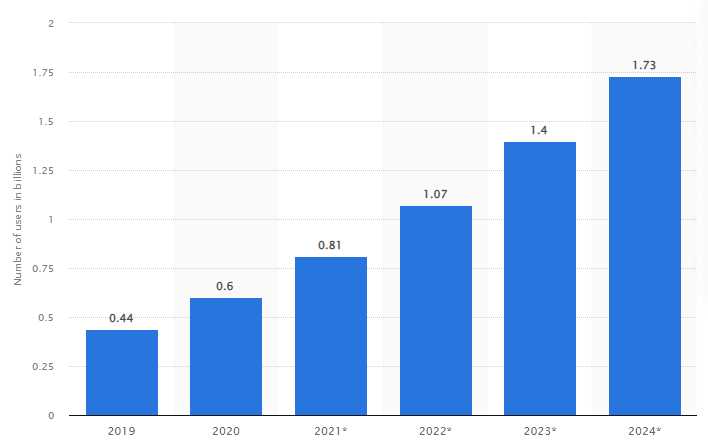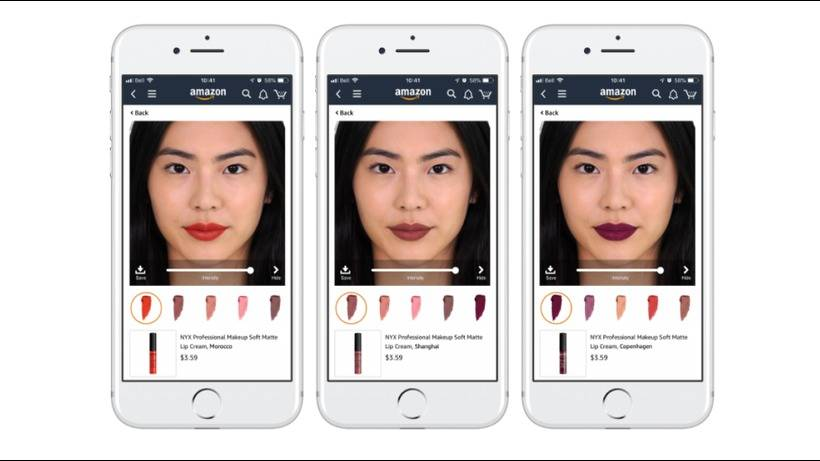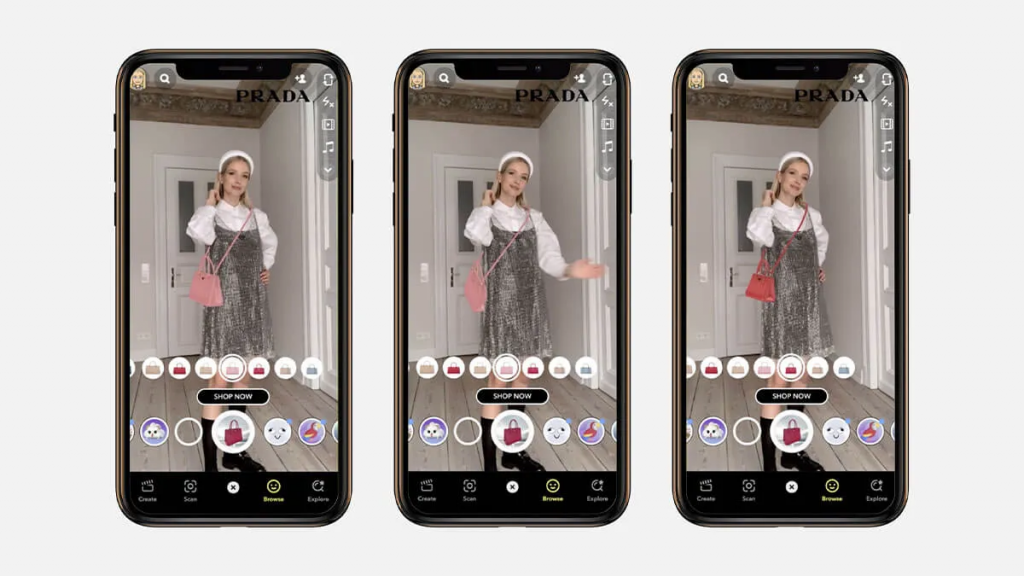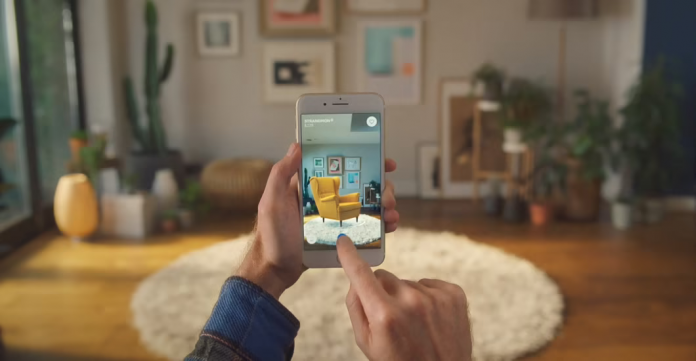The technology involved in Augmented and virtual reality has come a long way since it was first used in 1968 by a Harvard Professor (Yes, it was that long ago!). The very first stint with AR involved bulky headsets suspended from the ceiling fixed in an isolated room. The professor even had a name for the contraption — The Sword of Damocles.
AR technology has evolved swiftly ever since. It has disrupted almost every industry, be it healthcare, travel, or retail. Naturally, with the number of online shoppers worldwide exceeding 2.14 billion, a huge chunk of them are exposed to and use AR during their shopping expeditions.
Also, the number of mobile AR users is likely to surpass a billion mark in 2022.

The key to smoothly integrating AR into your strategies is to understand its various applications in your eCommerce business. It can act as a great marketing tool by turning almost every customer interaction into an experiential marketing opportunity.
With that said, let’s dive into some of the advantages of AR for retail and eCommerce companies.
1. Products Become Tangible
There is no denying that shopping online is more convenient than visiting a brick-and-mortar store. No matter how wide your range of products or quick delivery service is, customers often find that there’s something missing about the shopping experience as a whole.
Retailers find the “missing factor” often turns out to be a lack of tangibility. The two-dimensional screens often fail to embody the details of their products.
Here’s where AR steps in to bridge this gap. It helps bring your products to life and lets the users try them before they buy. This is a particularly prevalent feature in fashion, cosmetic, and furniture online stores. A 3D model of the products provides spatial context to help the customers make better shopping decisions as we can see in the following example.
One of the most renowned furniture companies, IKEA, was the first to implement AR in the retail industry in 2016. The company’s rodeo with an AR app called IKEA place changed the landscape of retail and eCommerce.
The app allows the 3D visualization of the products in their catalog. It scales the products according to the dimensions of the room with 98% accuracy. This proved to be a great advantage for users as they could try different pieces of furniture and choose one that best compliments their space.
2. Exponential Increase in Conversion Rates
As we have seen, online shopping leaves a lot of imagination for the customers. With the help of AR, they can better observe how that dress looks depending on their body type or if a particular shade of foundation will match their skin tone.
These are important details usually considered by the shoppers before making a decision.
Prior to the AR technology, the consumers solely relied on reviews and images on your product pages. However, this would lead to a lot of back and forth in their decision-making and a substantial cart abandonment rate.
This is evident as the customers using AR have 90% more conversion rates than those who don’t. AR eliminates most of the doubts the shoppers may garner about your products through a quick visualization which leads to faster conversions.
L’Oréal has achieved remarkable results after incorporating Artificial Intelligence (AI) powered AR tech into their strategies. They release projects that let the users try on makeup on their faces in real-time before making a purchase.
Their conversion rates have tripled and continue to rise with new AR applications on the way.

So integrating such AR experiences into your e-store, would not only delight your customers but also help you increase your sales.
3. Decreases Product Return Instances
Product returns are a grave pain point for retailers and eCommerce store owners. Goods worth $428 billion were returned to stores in 2020 alone. And 27% of the consumers express that they returned the goods because they were not as listed on the website. This accounts for a major setback in any business’s bottom line.
AR technology can help combat this situation by increasing customer satisfaction. The opportunity to virtually try before they buy any product leads to increased confidence and certainty about the purchases.
Big companies like Overstock.com and Nestle have observed a 25% decrease in their return rates after the incorporation of 3D models and AR into their product marketing.
4. Boosts Customer Engagement
Apart from being an extremely useful tool in decision-making, AR plays a crucial role in providing an immersive experience to the customers. It keeps your target audience hooked through exciting visuals and leads to greater brand awareness.
This technology can work throughout the marketing funnel and create significant engagement at every stage of the buyer’s journey.
Kellogs makes for an excellent example of a company that used AR strategies to skyrocket customer engagement. The brands banked on gamification through AR and made an interesting experience for their product “Coco Pops” in the Middle Eastern region.

This feature appealed massively to the children. The Island Adventure AR campaign transformed cereal boxes into islands populated by animals, which were then used to exchange animal knowledge questions.
5. Offers Self-Service Options in Stores
Customers can use augmented reality to avoid having to deal with customer service representatives. Many businesses are adopting augmented reality to provide self-service support after a transaction has been made at their brick-and-mortar outlet. Customers can use AR software to point their phones at a product and obtain a detailed self-service overlay.
The shoppers can access resources such as FAQ sites and helpsheets through this overlay. They can find solutions to common questions, saving them time and freeing up more resources for your staff. Users will be able to independently handle problems, resulting in fewer customer queries and improved customer satisfaction.
Mercedes, for example, has used augmented reality in its virtual assistant — Ask Mercedes. Drivers can scan an aspect of their car with assistance and have its functionality explained to them.
They can also inquire about any issues or flaws in the system’s functionality. The AR feature of the assistant, when combined with an AI chatbot, makes it considerably user-friendly.
6. Provides a Ton of Social Media Content
Augmented reality has the potential to be an effective social media marketing tool. It creates content that is both engaging and intuitive. The normal advertisements aren’t interactive enough and don’t always pique a user’s attention.
On the other hand, AR is an interactive technology. You can use it to create an interesting advertisement that grabs your target audience’s attention and encourages them to check out the product. Many businesses are using social media marketing these days, and retailers observe a huge benefit from these platforms.
AR is already intimately related to social media. Snapchat reports that an average of 200 million users engage with AR on a daily basis.
The platform has recently partnered with well-known brands like Prada and Farfetch to emphasize their social shopping features that heavily rely on AR.

Similarly, you can also take advantage of these features and interact with your customers by reposting user-generated content to stay connected with them.
7. Adds Value to the Product
The impact of augmented reality on customer service isn’t restricted to the pre-sale stage. In fact, the most intriguing applications of augmented reality occur at the point of sale. The concept of interactive packaging is one of the best instances of this.
AR-enabled packaging provides customers with a more engaging and valuable experience. Customers can view attractive visuals by pointing their phone at a product’s package.
For example, Heinz employed interactive packaging to convey relevant, actionable information. In 2011, the condiment brand used augmented reality to provide customers with a variety of tomato ketchup recipes.
Thus, they leveraged AR in a modest way to add value to an everyday product like tomato ketchup.
8. Helps Train Employees
Now, this point is quite beneficial across the board, not just for the retail and eCommerce industries. In fact, the tech was used to train pilots in the US Air Force during the early 1990s. Employee training is a time-consuming process.
This practice could be costly if the employee makes a mistake throughout the training process, causing the firm to lose money.
Using augmented reality in retail can reduce the risk associated with the training process. Employees can be safely educated to respond to a variety of scenarios, such as assisting consumers in finding a specific product or operating a conveyor belt.
Final Thoughts
With more pressure than ever on retailers to demonstrate profitable growth, it might be tough to make significant investments in what now appears to be a long-term game of new technologies. Today, augmented shopping relies on a mix of established and emerging technologies, but trends indicate that 3D technologies are being accepted by both businesses and consumers
A few product-centric use cases have already taken off really well and are now demonstrating clearly positive ROI. The future of shopping has arrived. As an eCommerce store owner, AR is definitely not something you need to think twice before investing in.
Author Bio
Oliver Thyra is the head SaaS copywriter and content strategist at Your Marketing Digest. His intense passion for marketing and his engineering background in software engineering has made him a guy who understands how to sell software subscriptions with words. In his free time, Oliver enjoys quality time with his pets (he has got 4 golden retrievers!).






